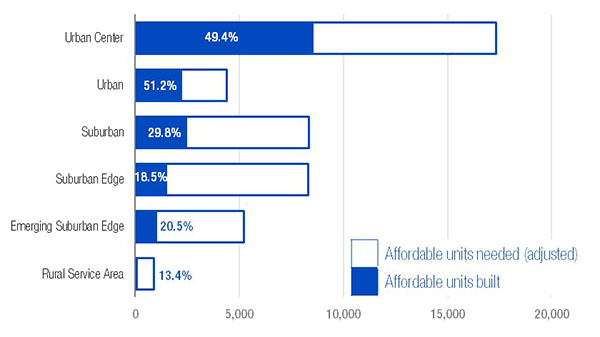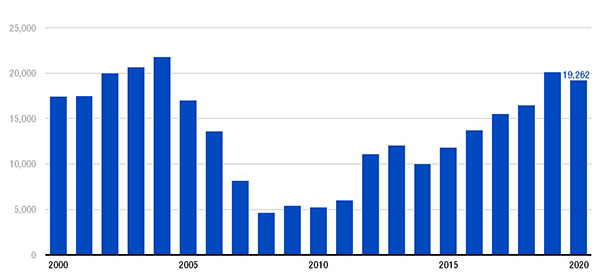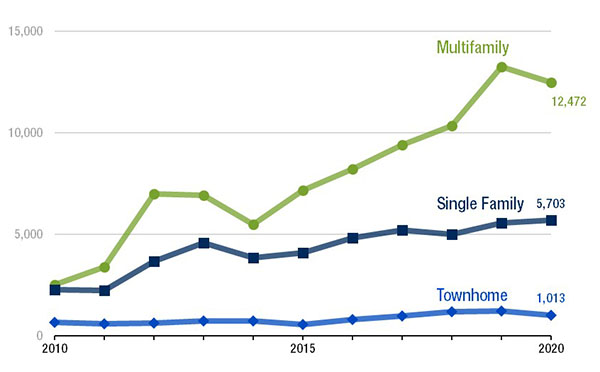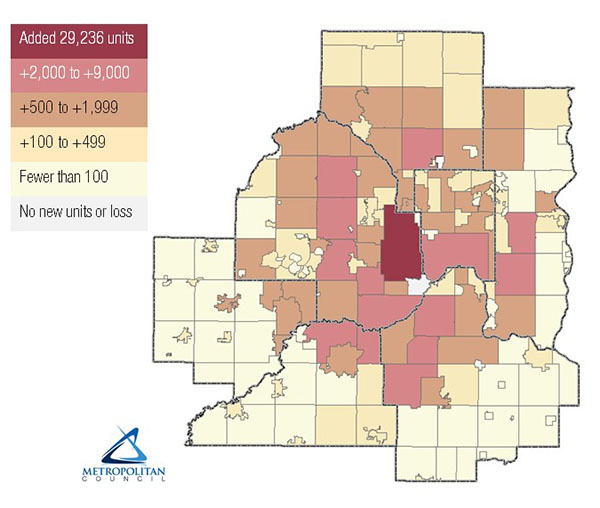Despite a 2020 pause in metro-area housing construction due to the pandemic, the number of housing units added to the region’s housing supply was on par with recent years. Metropolitan Council Community Development research staff say demand for housing remains strong, as does the need for affordable housing, especially for very low-income families.
“In an updated projection of the region’s need for affordable housing between 2011 and 2020, we estimated the region needed 44,570 new affordable homes,” said senior researcher Krysten Ryba-Tures. “The number of affordable units built during that period was about 16,400. A large share of these were built in the urban area*, including the central cities and neighboring communities.”
The Need for New Affordable Housing between 2011 and 2020 was Largely Unmet

Most new affordable housing in the region from 2011 to 2020 was built in the central cities and neighboring communities, but the region fell far short of the overall need for affordable housing. Source: Metropolitan Council Affordable Housing Production Survey and Building Permit Survey; Metropolitan Council’s annual population estimates, 2011; and U.S. Census Bureau, Decennial Census, 2020. Learn more about the allocation of affordable housing need.
What does “affordable” housing mean?
Met Council staff briefed Council members in September on data reflecting residential development and affordable housing production.
What’s considered affordable is based on the region’s area median income (AMI) of $103,400 for a family of four. For example, a one-bedroom unit renting for $582 is considered affordable to a family of four with earnings of less than $31,000 (30% of AMI). A $293,500 single-family home is deemed affordable for a family of four with earnings of $78,500 or 80% of AMI.
At the end of July, according to real estate market data, the median rent for a one-bedroom unit in the region was $1,180/month. The median sales price for a new single-family home in the region was $450,000 and $343,000 for an existing home.
“Given the cost of housing, you can see the challenges that lower-income families face,” said Ryba-Tures. “Housing that’s affordable remains out of reach for many families, an issue that’s prevalent and persistent despite some gains in affordable housing production. In 21 cities in the region, the median household income is at or less than $62,040. All cities in the region have households with incomes at or below $31,000, and the vast majority are cost-burdened,” said Ryba-Tures.
Find more information on area median income and housing affordability.
Shortage of deeply affordable housing has a price
“The data tell us the direst need is among families earning at or below $31,000, or 30% of the AMI,” said Tara Beard, Livable Communities manager. “That income represents a single-earner household working for $15 an hour. The discrepancy between need and production shows us that it’s extremely difficult to build new housing that is deeply affordable.
“The outcomes of housing unaffordability and instability are predictable and evident all around us,” Beard said. “People sheltering on transit, growing encampments, an underemployed workforce despite a desperate need for workers, increased social service needs and costs, and poor school performance in unstably housed kids.”
Few Units Affordable at 30% Area Median Income are Built

The discrepancy between affordable housing need and production is the greatest for households at or below 30% of AMI or $31,000. Source: Metropolitan Council Affordable Housing Production Survey and Building Permit Survey; Metropolitan Council’s Allocation of Affordable Housing Need, 2021-2030.
Met Council funding, while helpful, is a “drop in the bucket”
Beard said there are things the Met Council can do to address residents with the greatest need, such as targeting more of its available funds to families with earnings of $31,000 or less. But that represents a drop in the bucket. The ability of the region to thrive and prosper means a robust region-wide effort to better meet the needs of those with lesser means, she said.
“We will keep working to make affordable housing available, but it’s also about wages,” responded Council member Judy Johnson. “There is a bigger picture here. I understand there is a cost of doing business and that small businesses drive the economic engine of this country, but one or two wage-earners in a household earning minimum wage or even $15 an hour still leaves families in a precarious situation.”
Residential development: demand remains strong
Looking at residential development overall, Council researchers say demand for housing remains strong, fueled by years of production shortfall and steady population growth in the Twin Cities.
“Early indications are that construction activity will remain strong through 2021 despite some of the issues we faced, such as skyrocketing prices for lumber and other construction materials, disrupted supply lines, and labor shortages,” said researcher Joel Nyhus.
2020 Housing Gains were on Par with 2019, Despite Pandemic Impacts

Housing units added in 2020 was on par with recent years, despite the pandemic. Source: Metropolitan Council’s Building Permit Survey.
Multifamily remains the predominate housing type in new construction, though age-restricted units, primarily senior housing, showed a notable decline in 2020. New single-family homes trended upward in the 2010-2020 decade.
Multifamily Housing Remains the Predominant Type of New Units

Multifamily housing was the predominant type of housing added to the region’s housing supply between 2010 and 2020. Source: Metropolitan Council’s Building Permit Survey.
Minneapolis was, by far, the highest producer of new housing units during the past decade.
Housing Production in the Twin Cities Region, 2010-2020

The City of Minneapolis added the most new housing units between 2010 and 2020 among metro-area communities. Source: Metropolitan Council’s Building Permit Survey.
Met Council findings are based on residential building permit survey data collected from local units of government.
* “Urban” communities: Bloomington, Brooklyn Center, Columbia Heights, Crystal, Falcon Heights, Fort Snelling, Golden Valley, Hilltop, Hopkins, Lauderdale, Maplewood, Minneapolis, New Brighton, New Hope, Newport, North St. Paul, Osseo, Richfield, Robbinsdale, Roseville, South St. Paul, St. Anthony, St. Louis Park, Saint Paul, and West St. Paul.